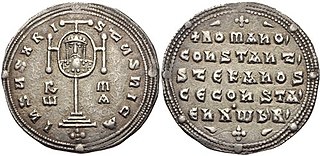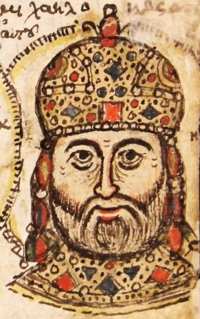 W
WAlexios Komnenos, latinised as Alexius Comnenus, was the eldest son of the Byzantine emperor John II Komnenos and his wife Eirene of Hungary. He was born in February 1106 at Balabista in Macedonia, was made co-emperor with his father at 16 or 17 years of age and died on 2 August 1142 at Attalia, Pamphylia. He was an elder brother of the emperor Manuel I Komnenos, and had a twin sister, Maria Komnene.
 W
WAndronikos V Palaiologos or Andronicus V Palaeologus was the Byzantine ruler of the city of Thessalonica and surrounding territories from 1403 to his death in 1407, alongside his father John VII Palaiologos. Though they did not control Constantinople, John and Andronikos ruled Thessalonica with the full Byzantine imperial title, recognized by the ruling senior emperor, John VII's uncle Manuel II Palaiologos.
 W
WConstantine was a junior Byzantine emperor from January 868 to 3 September 879. His parentage is a matter of debate, but he is generally assumed to be the son of Byzantine Emperor Basil I and his first wife, Maria or second wife Eudokia Ingerina; although other theories include him being the son of Emperor Michael III and Eudokia. Constantine was made co-emperor by his father in c. January 868. He was engaged to Ermengard of Italy, the daughter of Holy Roman Emperor Louis II, in 870/871, but it is not known if he ever married her; some sources take the affirmative stance, while others argue there is no concrete evidence. As emperor, he served in several campaigns alongside his father, including one in Syria, for which he shared a triumph.
 W
WSymbatios, variously also Sabbatios (Σαββάτιος) or Sambates (Σαμβάτης) in some sources, was the eldest son of the Byzantine emperor Leo V the Armenian. Soon after the coronation of his father, he was crowned co-emperor and renamed Constantine. He reigned nominally along with his father until the latter's deposition in 820, after which he was exiled to Prote, one of the Princes Islands, as a monk.
 W
WConstantine was a prince of the Byzantine Empire. He appears in his father's coins bearing the title despotes, although it's possible that he was crowned emperor soon after, as his relatives Anna, Anastasia and the future Michael III were also crowned shortly after their birth.
 W
WAndronikos Doukas, Latinized as Andronicus Ducas, was the third son of Byzantine emperor Constantine X Doukas and younger brother of Byzantine emperor Michael VII Doukas. Unlike his other brothers, he was not named junior co-emperor by his father, and was raised to the dignity only by Romanos IV Diogenes. He is otherwise relatively insignificant, and was not involved in the affairs of state to any degree.
 W
WConstantine Doukas or Ducas, was Byzantine junior emperor from 1074 to 1078, and again from 1081 to 1087. He was born to Emperor Michael VII and Empress Maria of Alania in late 1074, and elevated to junior emperor in the same year. He was junior emperor until 1078, when Michael VII was replaced by Nikephoros III Botaneiates. Because Constantine was not made junior emperor under Nikephoros III, his betrothal to Olympias, the daughter of Robert Guiscard, was broken, which Robert Guiscard used as a pretext to invade the Byzantine Empire. John Doukas forced Nikephoros to abdicate to Alexios I Komnenos in 1081, and shortly after Alexios elevated Constantine to junior emperor under himself. Constantine remained junior emperor until 1087, when Alexios had a son, John II Komnenos. Constantine died in c. 1095.
 W
WKonstantios Doukas, Latinized as Constantius Ducas, was a junior Byzantine emperor from 1060–1078, and a senior Byzantine emperor for a short time in 1078. Konstantios was the son of Emperor Constantine X Doukas and Empress Eudokia Makrembolitissa. Upon his birth, he was elevated to junior emperor, along with his brother Michael VII. He remained as junior emperor during the reigns of Constantine, Romanos IV Diogenes, and Michael VII, before he became senior emperor on 31 March 1078, due to the abdication of Michael VII. He was soon handed over to Nikephoros III, a usurper, due to his inability to rule. He was sent to live in a monastery, where he stayed until recalled by Alexios I Komnenos, who made him a general. He was killed on 18 October 1081, in the Battle of Dyrrhachium.
 W
WHeraclius was Byzantine co-emperor from 659 to 681. He was the son of Emperor Constans II and Fausta, who was elevated in 659, before his father departed for Italy. After the death of Constans, Heraclius' brother Constantine IV ascended the throne as senior emperor. Constantine attempted to have both Heraclius and Tiberius removed as co-emperors. However, this sparked a popular revolt in 681. Constantine ended the revolt by promising to accede to the demands of the rebels, sending them home, but bringing their leaders into Constantinople. Once there, Constantine had them executed, then imprisoned Tiberius and Heraclius and had their noses slit, after which point they disappear from history.
 W
WMatthew Asen Kantakouzenos or Cantacuzenus was Byzantine Emperor from 1353 to 1357 and later Despot of the Morea from 1380 to 1383.
 W
WChristopher Lekapenos or Lecapenus was the eldest son of Emperor Romanos I Lekapenos and co-emperor of the Eastern Roman Empire from 921 until his death in 931. Christopher was given the position of megas hetaireiarches in spring 919, after Romanos assumed the position of basileopator. Romanos, in order to give his family precedence over the more Macedonian line, raised Christopher to co-emperor on 21 May 921. In 928 Christopher's father-in-law, Niketas, unsuccessfully attempted to incite Christopher to usurp his father, resulting in Niketas being banished. Christopher died in August 931, succeeded by his father and two brothers, Stephen Lekapenos and Constantine Lekapenos, and Constantine VII. In December 944 his brothers overthrew and exiled his father, but they themselves were exiled after attempting to oust Constantine VII.
 W
WConstantine Lekapenos or Lecapenus was the third son of the Byzantine emperor Romanos I Lekapenos, and co-emperor from 924 to 945. With his elder brother Stephen, he deposed Romanos I in December 944, but was overthrown and exiled by the legitimate emperor Constantine VII a few weeks later. Constantine was exiled to the island of Samothrace, where he was killed while attempting to escape sometime between 946 and 948.
 W
WStephen Lekapenos or Lecapenus was the second son of the Byzantine emperor Romanos I Lekapenos, and co-emperor from 924 to 945. With his younger brother Constantine, he deposed Romanos I in December 944, but was overthrown and exiled by the legitimate emperor Constantine VII a few weeks later. Stephen lived out his life in exile on the island of Lesbos, where he died on Easter 963.
 W
WMarcus was the son of the East Roman or Byzantine general and usurper Basiliscus, and Zenonis. He was acclaimed Caesar in 475 and later promoted to Augustus, ruling as junior co-emperor to his father. When Zeno reoccupied Constantinople in late August 476, Marcus, with his parents, took refuge in a church. Zeno promised not to spill their blood, so he exiled them to Limnae in Cappadocia and subsequently starved them to death.
 W
WNikephoros was junior Byzantine Emperor from 741 to 2 November 743. He was crowned after his father, Artabasdos usurped Emperor Constantine V. Constantine seized power again on 2 November 743, and Nikephoros, Artabasdos, and Niketas were blinded and confined in the Chora Church.
 W
WMichael IX Palaiologos or Palaeologus, was Byzantine Emperor together with his father Andronikos II Palaiologos from 1294 until his death.
 W
WTheodosius was the eldest son of Byzantine Emperor Maurice and was co-emperor from 590 until his deposition and execution during a military revolt in November 602. Along with his father-in-law Germanus, he was briefly proposed as successor to Maurice by the troops, but the army eventually favoured Phocas instead. Sent in an abortive mission to secure aid from Sassanid Persia by his father, Theodosius was captured and executed by Phocas's supporters a few days after Maurice. Nevertheless, rumours spread that he had survived the execution, and became popular to the extent that a man who purported to be Theodosius was entertained by the Persians as a pretext for launching a war against Byzantium.
 W
WTheophylact or Theophylaktos was the eldest son of the Byzantine emperor Michael I Rangabe and grandson, on his mother's side, of Nikephoros I. He was junior co-emperor alongside his father for the duration of the latter's reign, and was tonsured, castrated, and exiled to Plate Island after his overthrow, under the monastic name Eustratius.
 W
WTiberius was Byzantine co-emperor from 659 to 681. He was the son of Constans II and Fausta, who was elevated in 659, before his father departed for Italy. After the death of Constans, Tiberius' brother Constantine IV, ascended the throne as senior emperor. Constantine attempted to have both Tiberius and Heraclius removed as co-emperors, which sparked a popular revolt, in 681. Constantine ended the revolt by promising to accede to the demands of the rebels, sending them home, but bringing their leaders into Constantinople. Once there, Constantine had them executed, then imprisoned Tiberius and Heraclius and had them mutilated, after which point they disappear from history.
 W
WTiberius, sometimes enumerated as Tiberius IV, was the son of Emperor Justinian II and Theodora of Khazaria. He served as co-emperor of the Byzantine Empire with his father Justinian II, from 706–711. Both were killed in 711, when Bardanes led a rebellion which marched on Constantinople. After Tiberius' death, two different individuals impersonated him, with one, named Bashir, going on to be hosted by Hisham ibn Abd al-Malik, the Umayyad caliph, before his lie was discovered and he was crucified.